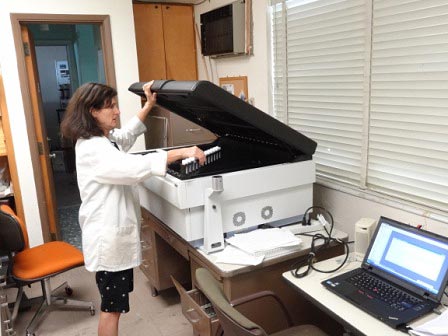List of Equipment necessary:
- sample bottles, empty
- 200 ml glass beaker
- Bottle filled with Count-Off soap and labeled as C.O. #1
- Disposable gloves
- Funnel with bottle attachment or conical paper cups with snipped bottom
- Flat sponges
- Trash bag notebook
Quantities vary, depending on how many samples are requested. Please provide your own CLEAN (preferable unused) bucket. Please return all of the above items in the SWAB Kit except for the used sponges, gloves and trash bag.
Sampling Procedures
selection of sampling areas is made according to the judgement of possible high-risk places. for instance, where known artificial tracer experiments have been going on previously, and especially in areas of reported spills.
a descriptive record is kept of locations swabbed and corresponding bottle numbers, by marking the sample sites clearly on a sketch of the ship area where swab-test took place. use enclosed notebook.
- Fill the bucket with approximately 7 liters or 2 gallons of freshwater from nearest sink.
- Add one 60 ml bottle of a heavy duty detergent such as Count-Off (a bottle is enclosed in the SWAB Kit marked C.O. #1) and mix. Place the beaker in the bucket, where it will remain between sample collections.
- Collect Bucket Blank, using bottle #2. Screw the funnel onto the neck of the bottle and wearing a glove, dip a fresh sponge into the bucket and absorb 60 ml of the solution. Then squeeze the liquid from the sponge through the funnel into the bottle.
- 200 ml of the solution using beaker line as measure is spread out over the 1m2 area to be tested using the enclosed beaker. Be careful not to contaminate the beaker by setting it down on the deck, counter, etc., merely place it back in the bucket between each use.
- Using a disposable glove and sponge, spread the solution on the surface that is being tested and re-absorb the solution, emptying it into the sample bottle through the attached funnel or paper cups.
- After approx. 60 ml is collected in the bottle, remove the glove and the sponge and dispose in the enclosed trash bag.
- Rinse funnel in a sink using fresh tap water after each sample is collected. If a sink is unavailable, fill a CLEAN wash bottle with the bucket water and use that to rinse funnel. If using paper cups, throw away and use new one
- Proceed to the next sampling area. Repeat with new glove and sponge.
- After all of the samples have been collected, collect final Bucket Blank by filling s sponge from the bucket and funneling it into an empty bottle.
- Rinse FUNNEL, BEAKER and BUCKET with fresh water, replace into plastic bags and return equipment to the SWAB Kit.
- Return entire SWAB Kit to the Tritium Lab at the address on the letterhead.
- * SAMPLE 1 IS MACHINE BLANK — PREPARED AT THE TRITIUM LAB
Mesurement Procedures
Back in the laboratory, particulates are removed from the sample by centrifuging. Then an aliquot of 5 ml of the centrifuged sample is mixed with 15 ml of liquid scintillation cocktail. The liquid scintillation counter, a Perkin-Elmer Tri-Carb 2910 TR, has three channels: viz., one tuned for optimal 3H alone, one for 3H with 14C overlay, and a 14C channel. The samples are counted for six 60-minute periods each, so as to obtain sensitivity of the order of one count per minute above background in each channel. The results are reported on the amount of radioactivity recovered from each of the sampling areas, as dpm/m2 with associated 1 sigma errors. Radioactive, water-insoluble, solid particles will not be included by our procedure. Ships and radiation vans should preferably be tested both before and after a cruise where artificial tracers are used.





